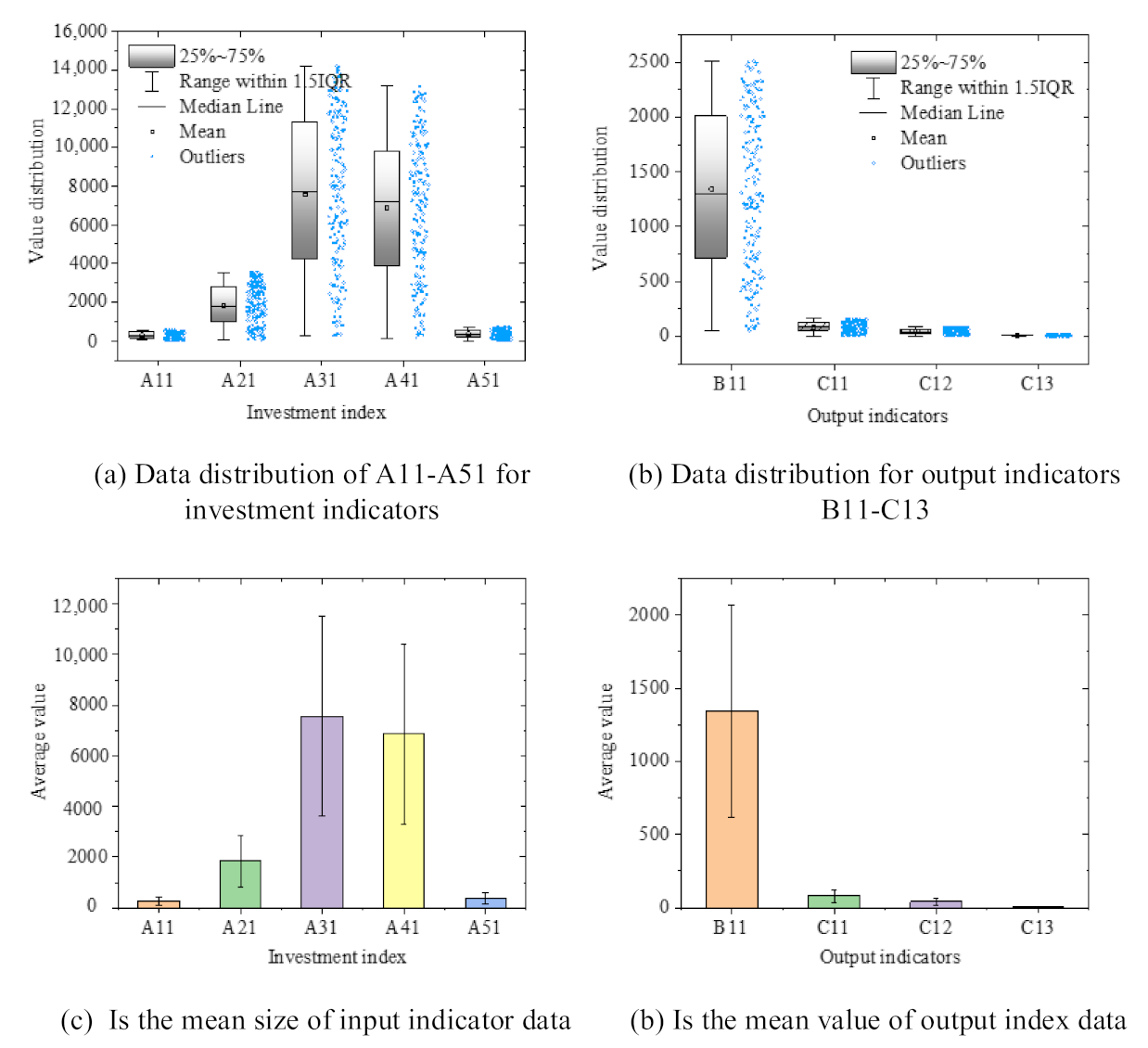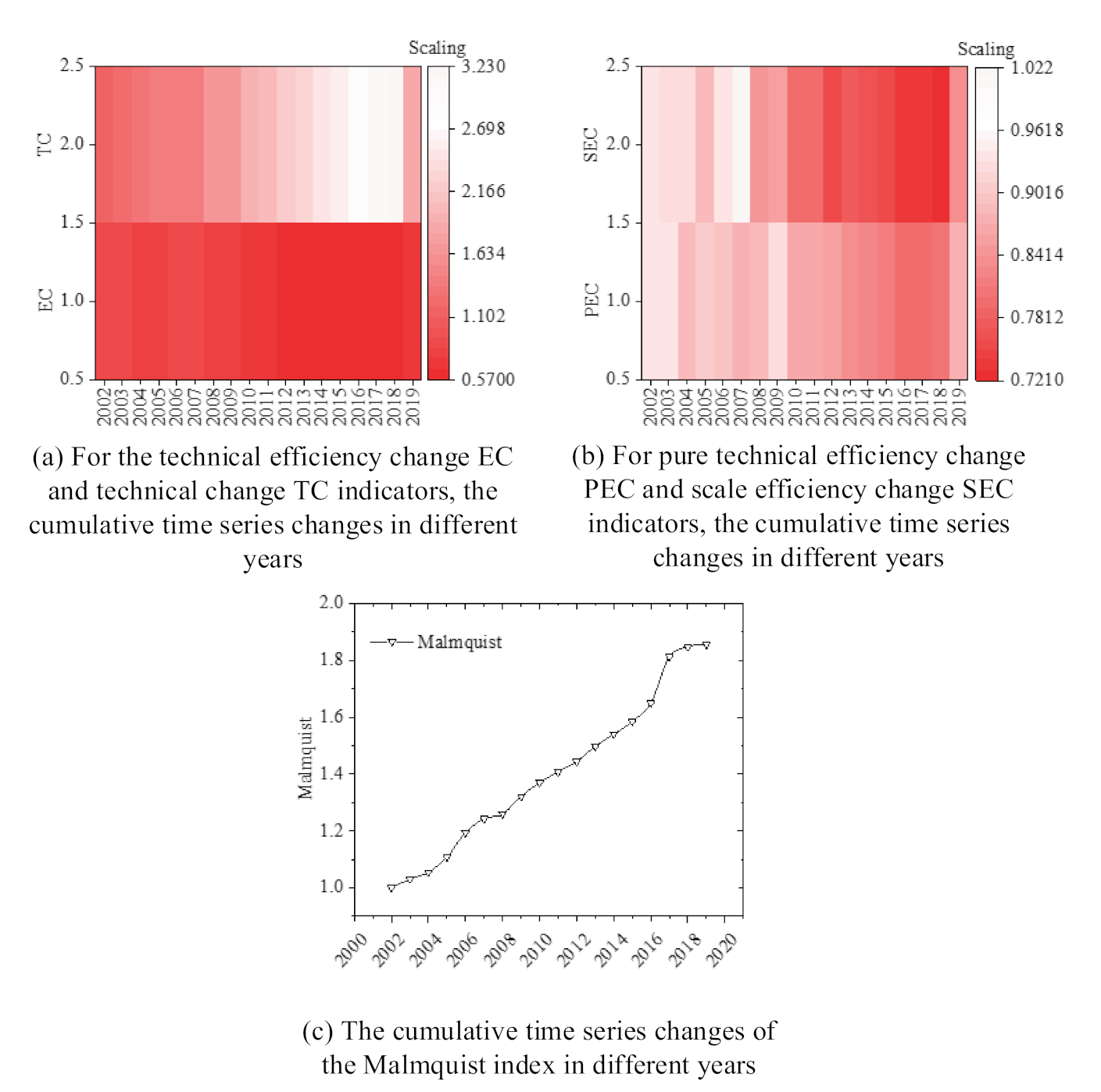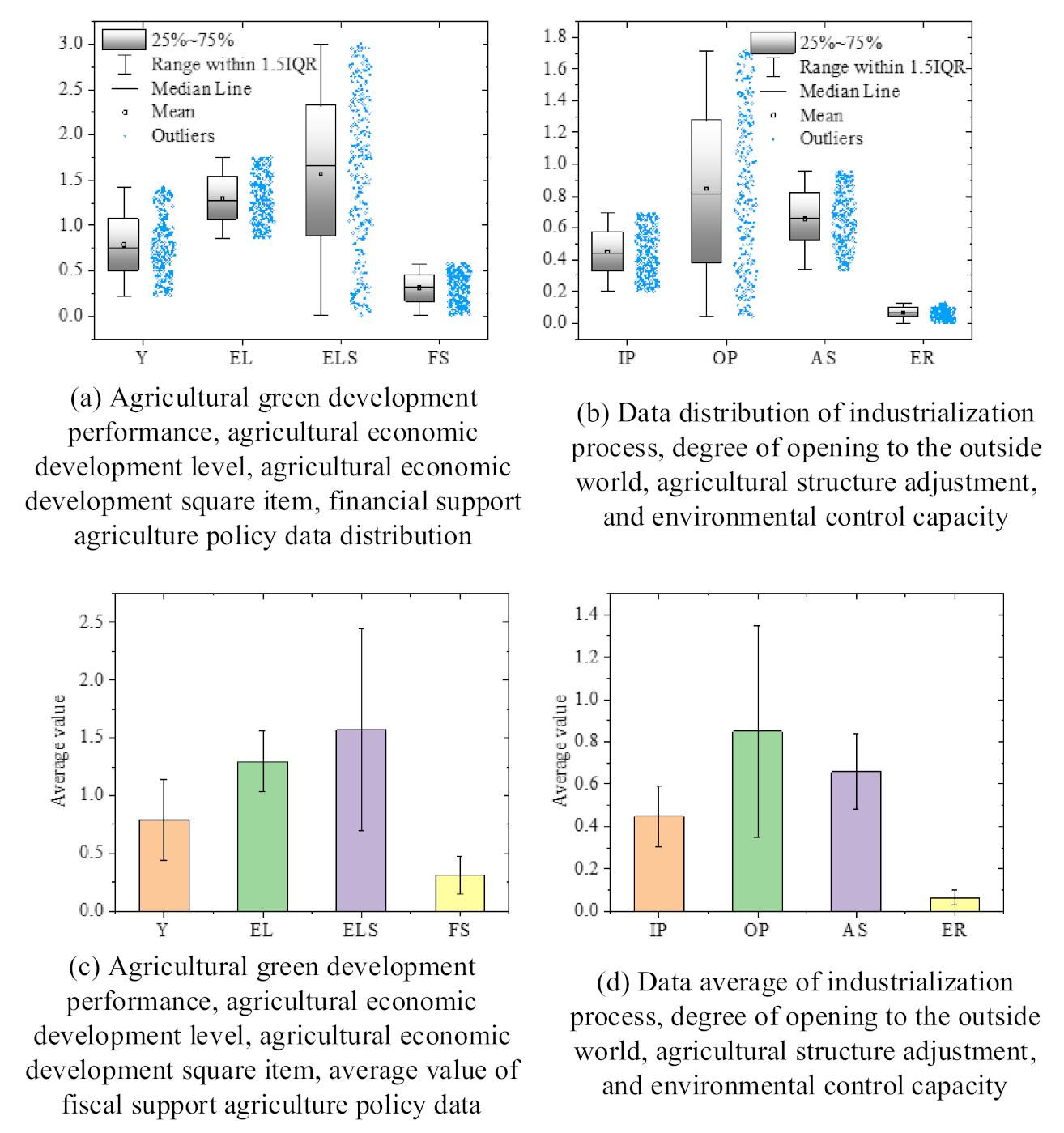Green Agricultural Development Based on Information Communication Technology and the Panel Space Measurement Model
Abstract
1. Introduction
2. Literature Overview
2.1. Evaluation on Performance of Agricultural GD
2.2. Regional Differences in Performance of Agricultural GD
2.3. Influencing Factors on Performance of Agricultural GD
3. Research Methods
3.1. Information Communication Technology
3.2. PSM Model
3.3. Construction of Indicator System
3.4. Construction of Performance Model
3.5. Data Acquisition Mode
4. Results
4.1. Descriptive Analysis of Variables
4.2. Analysis on Overall Characteristics in China
4.3. Cumulative Changes
4.4. Changes in Different Regions
4.5. PSM Results
5. Governance Recommendations
5.1. Monitoring the Pollution Source and Implementing both Rewards and Punishments
5.2. Enhancing Environmental Supervision and Optimizing Government Functions
5.3. Utilizing Various Policies and Establishing the Indicator System
5.4. Accelerating Technological Innovation and Exerting the Technological Strengths
6. Conclusions
Author Contributions
Funding
Institutional Review Board Statement
Informed Consent Statement
Data Availability Statement
Acknowledgments
Conflicts of Interest
References
- Githiru, M.; Njambuya, J.W. Globalization and biodiversity conservation problems: Polycentric REDD+ solutions. Land 2019, 8, 35–43. [Google Scholar] [CrossRef]
- Yu, J.; Wu, J. The sustainability of agricultural development in China: The agriculture–environment nexus. Sustainability 2018, 10, 1776–1782. [Google Scholar] [CrossRef]
- Cao, Y.; Chai, L.; Yan, X.; Liang, Y. Drivers of the Growing Water, Carbon and Ecological Footprints of the Chinese Diet from 1961 to 2017. Int. J. Environ. Res. Public Health 2020, 17, 1803–1812. [Google Scholar] [CrossRef]
- Long, H.; Liu, H.; Li, X.; Chen, L. An Evolutionary Game Theory Study for Construction and Demolition Waste Recycling Considering Green Development Performance under the Chinese Government’s Reward–Penalty Mechanism. Int. J. Environ. Res. Public Health 2020, 17, 6303–6312. [Google Scholar] [CrossRef] [PubMed]
- Melović, B.; Cirović, D.; Backovic-Vulić, T.; Dudić, B.; Gubinova, K. Attracting Green Consumers as a Basis for Creating Sustainable Marketing Strategy on the Organic Market—Relevance for Sustainable Agriculture Business Development. Foods 2020, 9, 1552–1562. [Google Scholar] [CrossRef]
- Xu, J.; Zhang, Z.; Zhang, X.; Ishfaq, M.; Zhong, J.; Li, W.; Zhang, F.; Li, X. Green Food Development in China: Experiences and Challenges. Agriculture 2020, 10, 614–623. [Google Scholar] [CrossRef]
- Castillo-Henríquez, L.; Alfaro-Aguilar, K.; Ugalde-Álvarez, J.; Vega-Fernández, L.; Montes de Oca-Vásquez, G.; Vega-Baudrit, J.R. Green Synthesis of Gold and Silver Nanoparticles from Plant Extracts and Their Possible Applications as Antimicrobial Agents in the Agricultural Area. Nanomaterials 2020, 10, 1763–1773. [Google Scholar] [CrossRef]
- Yacamán Ochoa, C.; Ferrer Jiménez, D.; Mata Olmo, R. Green Infrastructure Planning in Metropolitan Regions to Improve the Connectivity of Agricultural Landscapes and Food Security. Land 2020, 9, 414–425. [Google Scholar] [CrossRef]
- Choi, Y.J.; Baek, J. Does FDI really matter to economic growth in India? Economies 2017, 5, 20–26. [Google Scholar] [CrossRef]
- Hsiao, W.-L.; Hu, J.-L.; Hsiao, C.; Chang, M.-C. Energy efficiency of the Baltic Sea countries: An application of stochastic frontier analysis. Energies 2019, 12, 104–113. [Google Scholar] [CrossRef]
- Niu, D.; Song, Z.; Xiao, X.; Wang, Y. Analysis of wind turbine micrositing efficiency: An application of two-subprocess data envelopment analysis method. J. Clean. Prod. 2018, 170, 193–204. [Google Scholar] [CrossRef]
- Tapia, J.F.D.; Promentilla, M.A.B.; Tseng, M.-L.; Tan, R.R. Screening of carbon dioxide utilization options using hybrid Analytic Hierarchy Process-Data Envelopment Analysis method. J. Clean. Prod. 2017, 165, 1361–1370. [Google Scholar] [CrossRef]
- Shen, J.; Zhu, Q.; Jiao, X.; Ying, H.; Wang, H.; Wen, X.; Xu, W.; Li, T.; Cong, W.; Liu, X. Agriculture green development: A model for China and the world. Front. Agric. Sci. Eng. 2020, 7, 5–13. [Google Scholar] [CrossRef]
- Shen, N.; Liao, H.; Deng, R.; Wang, Q. Different types of environmental regulations and the heterogeneous influence on the environmental total factor productivity: Empirical analysis of China’s industry. J. Clean. Prod. 2019, 211, 171–184. [Google Scholar] [CrossRef]
- Han, Z.; Han, C.; Yang, C. Spatial econometric analysis of environmental total factor productivity of animal husbandry and its influencing factors in China during 2001–2017. Sci. Total Environ. 2020, 723, 137726–137736. [Google Scholar] [CrossRef]
- Guo, B.; He, D.; Zhao, X.; Zhang, Z.; Dong, Y. Analysis on the spatiotemporal patterns and driving mechanisms of China’s agricultural production efficiency from 2000 to 2015. Phys. Chem. Earth Parts A/B/C 2020, 120, 102909–102916. [Google Scholar] [CrossRef]
- Li, M.; Wang, J. Spatial-temporal distribution characteristics and driving mechanism of green total factor productivity in China’s logistics industry. Pol. J. Environ. Stud. 2020, 30, 201–213. [Google Scholar] [CrossRef]
- Zhu, Y.; Liang, D.; Liu, T. Can China’s underdeveloped regions catch up with green economy? A convergence analysis from the perspective of environmental total factor productivity. J. Clean. Prod. 2020, 255, 120216–120226. [Google Scholar] [CrossRef]
- Qin, Q.; Yan, H.; Liu, J.; Chen, X.; Ye, B. China’s agricultural GHG emission efficiency: Regional disparity and spatial dynamic evolution. Environ. Geochem. Health 2020, 1–17. [Google Scholar] [CrossRef]
- Chen, Y.; Liu, B.; Shen, Y.; Wang, X. Spatial analysis of change trend and influencing factors of total factor productivity in China’s regional construction industry. Appl. Econ. 2018, 50, 2824–2843. [Google Scholar] [CrossRef]
- Feng, C.; Huang, J.-B.; Wang, M. Analysis of green total-factor productivity in China’s regional metal industry: A meta-frontier approach. Resour. Policy 2018, 58, 219–229. [Google Scholar] [CrossRef]
- Wang, K.-L.; Pang, S.-Q.; Ding, L.-L.; Miao, Z. Combining the biennial Malmquist–Luenberger index and panel quantile regression to analyze the green total factor productivity of the industrial sector in China. Sci. Total Environ. 2020, 739, 140280–140286. [Google Scholar] [CrossRef] [PubMed]
- Baležentis, T.; Blancard, S.; Shen, Z.; Štreimikienė, D. Analysis of environmental total factor productivity evolution in European agricultural sector. Decis. Sci. 2019, 365–373. [Google Scholar] [CrossRef]
- Liu, J.; Dong, C.; Liu, S.; Rahman, S.; Sriboonchitta, S. Sources of Total-Factor Productivity and Efficiency Changes in China’s Agriculture. Agriculture 2020, 10, 279–286. [Google Scholar] [CrossRef]
- Li, N.; Jiang, Y.; Yu, Z.; Shang, L. Analysis of agriculture total-factor energy efficiency in China based on DEA and malmquist indices. Energy Procedia 2017, 142, 2397–2402. [Google Scholar] [CrossRef]
- Wu, L.; Zhang, Z. Impact and threshold effect of Internet technology upgrade on forestry green total factor productivity: Evidence from China. J. Clean. Prod. 2020, 271, 122657–122669. [Google Scholar] [CrossRef]
- Ratheeswari, K. Information communication technology in education. J. Appl. Adv. Res. 2018, 3, S45–S47. [Google Scholar] [CrossRef]
- Han, J.-H.; Park, C.-H.; Kwon, J.H.; Lee, J.; Kim, T.S.; Jang, Y.Y. Performance Evaluation of Autonomous Driving Control Algorithm for a Crawler-Type Agricultural Vehicle Based on Low-Cost Multi-Sensor Fusion Positioning. Appl. Sci. 2020, 10, 4667–4673. [Google Scholar] [CrossRef]
- Bevilacqua, I.; Capello, G.; Biddoccu, M. Local- and Plot-Scale Measurements of Soil Moisture: Time and Spatially Resolved Field Techniques in Plain, Hill and Mountain Sites. Adv. Hydro Meteorol. Monit. 2018, 21–36. [Google Scholar]
- Feng, Z.; Chen, W. Environmental regulation, green innovation, and industrial green development: An empirical analysis based on the Spatial Durbin model. Sustainability 2018, 10, 223–236. [Google Scholar] [CrossRef]
- Shen, C.-W.; Min, C.; Wang, C.-C. Analyzing the trend of O2O commerce by bilingual text mining on social media. Comput. Hum. Behav. 2019, 101, 474–483. [Google Scholar] [CrossRef]
- Liu, Q.; Cheng, Z.; Chen, M. Effects of environmental education on environmental ethics and literacy based on virtual reality technology. Electron. Libr. 2019, 37, 860–877. [Google Scholar] [CrossRef]
- Feng, B.; Sun, K.; Chen, M.; Gao, T. The Impact of Core Technological Capabilities of High-Tech Industry on Sustainable Competitive Advantage. Sustainability 2020, 12, 2980. [Google Scholar] [CrossRef]
- Liu, Y.; Chen, M. From the Aspect of STEM to Discuss the Effect of Ecological Art Education on Knowledge Integration and Problem-Solving Capability. Ekoloji 2018, 27, 1705–1711. [Google Scholar]
- Chen, M.; Liu, Q.; Huang, S.; Dang, C. Environmental cost control system of manufacturing enterprises using artificial intelligence based on value chain of circular economy. Enterp. Inf. Syst. 2020. [Google Scholar] [CrossRef]






| Literature | Time | Method | Inputs | Outputs |
|---|---|---|---|---|
| Shen et al. (2020) [13] | 1978–2005 | DEA | Human capital, land, agricultural machinery, fertilizers, draught animals, and irrigation | Total output value of agriculture, forestry, animal husbandry, and fishery |
| Neng et al. (2019) [14] | 1978–2007 | SFA | Land, labor, agricultural capital stock, and intermediate input | Total output value of agriculture, forestry, animal husbandry, and fishery |
| Han et al. (2020) [15] | 1992–2007 | DEA | Machinery, fertilizer, labor, and land | Total output value of agriculture, forestry, animal husbandry, and fishery |
| Guo et al. (2020) [16] | 1999–2008 | DEA | Labor, capital, and technological progress | Total output value of agriculture, forestry, animal husbandry, and fishery and pollution from a nonpoint agricultural source |
| Li et al. (2020) [17] | 1998–2009 | DEA | Land, labor, draught animals, chemical fertilizers, Machinery, and water resources | Total output value of agriculture, forestry, animal husbandry, and fishery and pollution from a nonpoint agricultural source |
| Zhu et al. (2020) [18] | 1991–2010 | SFA | Labor and capital | Total output value of agriculture, forestry, animal husbandry, and fishery |
| Literature | Time | Sample Range | Conclusion |
|---|---|---|---|
| Qin et al. (2020) [19] | 1985–2005 | 29 provinces in China | There is no shrinking trend in agricultural TFP differences among provinces. |
| Chen et al. (2018) [20] | 1978–2008 | The whole country and three major regions | Agricultural GD growth shows significant regional imbalance. |
| Feng et al. (2018) [21] | 1993–2010 | 29 provinces in China | The growth of China’s agricultural green TFP shows a downward trend in the eastern, western, and central regions. |
| Wang et al. (2020) [22] | 1978–2008 | 28 provinces in China | China’s agricultural GD shows the fastest growth in the east, followed by the west. |
| Baležentis et al. (2019) [23] | 1978–2011 | 29 provinces in China | China’s agricultural GD shows the fastest growth in the east. |
| Literature | Time | Influencing Factors | Conclusion |
|---|---|---|---|
| Liu et al. (2020) [24] | 1991–2008 | Rural employees, technological progress, financial support for agriculture, and the status of agriculture in the overall economy | Rural employees have significant impacts on agriculture, and technological progress is the main reason for the growth of agricultural TFP. |
| Liu et al. (2020) [24] | 1995–2008 | Characteristics of agricultural production structure, regional characteristics, government fiscal policy, and education level | The improvement in the education levels of agricultural employees has played a positive role in the improvement of China’s agriculture. |
| Li et al. (2017) [25] | 1998–2011 | The level of rural economic development, investment in agricultural infrastructure, the proportion of aquaculture in the agricultural structure, expansion of the urban–rural income gap, and the fiscal support of agriculture policies | The improvement of rural economic development and the investment increases in agricultural infrastructure effectively improve the agricultural performance. |
| Wu and Zhang (2020) [26] | 1992–2012 | Labor capital content, proportion of irrigated area, proportion of wage income, proportion of agricultural fiscal expenditure, proportion of agricultural output value, and proportion of grain sown area | Labor capital content, proportion of irrigated area, proportion of wage income, and proportion of agricultural fiscal expenditure have positive impacts on agricultural performance. |
| Item | Primary Indicator | Secondary Indicator | Unit |
|---|---|---|---|
| Input indicators (A) | Water resource input (A1) | Agricultural water consumption (A11) | Hundred million cubic meters |
| Labor input (A2) | Employees in agriculture, forestry, animal husbandry, and fishery (A21) | Ten thousand people | |
| Land input (A3) | Total sown area of crops (A31) | Thousand hectares | |
| Capital input (A4) | The total power of agricultural machinery (A41) | Ten thousand kilowatts | |
| Chemical fertilizer input (A5) | Scalar amount of agricultural fertilizer application (A51) | Ten thousand tons | |
| Expected indicators (B) | Expected output (B1) | Added value of primary industry (B11) | 100 billion Yuan |
| Output indicators (C) | Unexpected output (C1) | Chemical oxygen demand (COD, C11) | Ten thousand tons |
| Total nitrogen (TN, C12) | Ten thousand tons | ||
| Total phosphorus (TP, C13) | Ten thousand tons |
| Variable | Symbol |
|---|---|
| Performance of agricultural GD | Y |
| Agricultural economic level | EL |
| Square item of agricultural economic level | ELS |
| Fiscal support of agriculture policies | FS |
| Industrialization process | IP |
| Level of opening-up | OP |
| Adjustment of agricultural structure | AS |
| Environmental regulatory capability of government | ER |
Publisher’s Note: MDPI stays neutral with regard to jurisdictional claims in published maps and institutional affiliations. |
© 2021 by the authors. Licensee MDPI, Basel, Switzerland. This article is an open access article distributed under the terms and conditions of the Creative Commons Attribution (CC BY) license (http://creativecommons.org/licenses/by/4.0/).
Share and Cite
Zhang, X.; Chen, H. Green Agricultural Development Based on Information Communication Technology and the Panel Space Measurement Model. Sustainability 2021, 13, 1147. https://doi.org/10.3390/su13031147
Zhang X, Chen H. Green Agricultural Development Based on Information Communication Technology and the Panel Space Measurement Model. Sustainability. 2021; 13(3):1147. https://doi.org/10.3390/su13031147
Chicago/Turabian StyleZhang, Xueyao, and Hong Chen. 2021. "Green Agricultural Development Based on Information Communication Technology and the Panel Space Measurement Model" Sustainability 13, no. 3: 1147. https://doi.org/10.3390/su13031147
APA StyleZhang, X., & Chen, H. (2021). Green Agricultural Development Based on Information Communication Technology and the Panel Space Measurement Model. Sustainability, 13(3), 1147. https://doi.org/10.3390/su13031147




